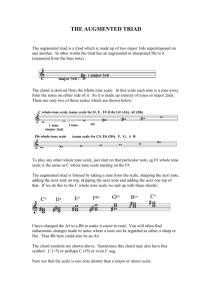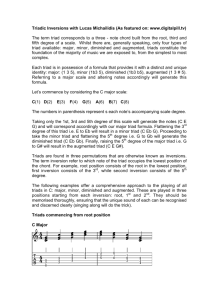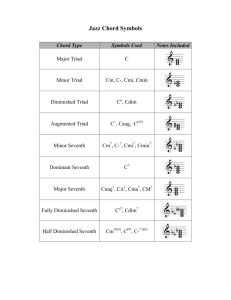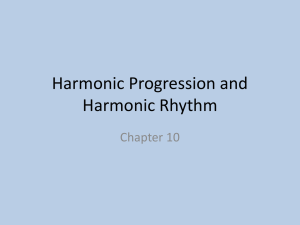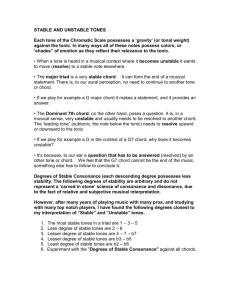Arpeggio Exercises
advertisement
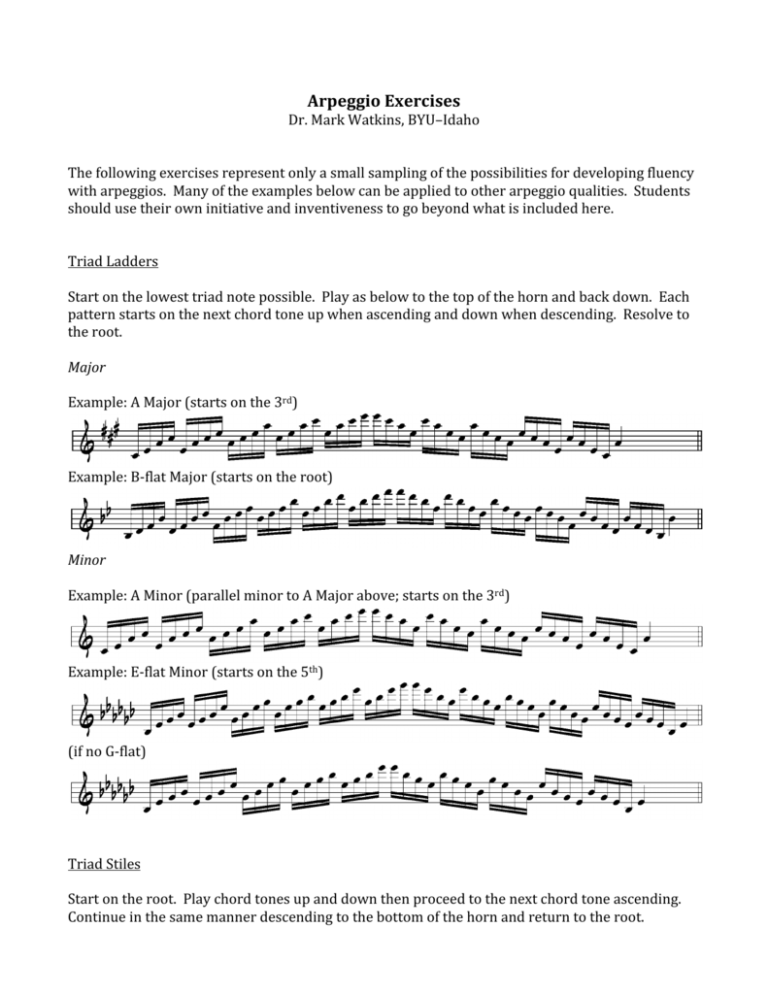
Arpeggio Exercises Dr. Mark Watkins, BYU–Idaho The following exercises represent only a small sampling of the possibilities for developing fluency with arpeggios. Many of the examples below can be applied to other arpeggio qualities. Students should use their own initiative and inventiveness to go beyond what is included here. Triad Ladders Start on the lowest triad note possible. Play as below to the top of the horn and back down. Each pattern starts on the next chord tone up when ascending and down when descending. Resolve to the root. Major Example: A Major (starts on the 3rd) Example: B‐flat Major (starts on the root) Minor Example: A Minor (parallel minor to A Major above; starts on the 3rd) Example: E‐flat Minor (starts on the 5th) (if no G‐flat) Triad Stiles Start on the root. Play chord tones up and down then proceed to the next chord tone ascending. Continue in the same manner descending to the bottom of the horn and return to the root. Example: A‐flat Major Do the same exercise with descending triads. Chord Tone Skips Start on the root, skip a tone ascending, play skipped tone, skip a tone ascending, play skipped tone, etc. Proceed to the top of the horn, reverse and play to the bottom of the horn and back to tonic. Major Examples follow in B‐flat, E‐flat, F‐sharp, and G. (if no F‐sharp) Minor Examples follow in B‐flat, C, E, and F‐sharp. (if no F‐sharp) Diminished and Augmented Triads The above exercises should be repeated with diminished and augmented triads. Diminished triads consist of two minor thirds. One can find the correct pitches by taking a minor triad and lowering the 5th. Example: C Minor to C Diminished Augmented triads consist of two major thirds. One can find the correct pitches by taking a major triad and raising the 5th. Example: C Major to C Augmented Triad Scales Ascending Arpeggio Descending Arpeggio Ascending Arpeggio, Ascending Scale/Descending Arpeggio, Descending Scale Descending Arpeggio, Ascending Scale/Ascending Arpeggio, Descending Scale Arpeggiated scale patterns can be applied to diminished and whole‐tone scales. Diminished scales are of limited transposition; meaning, applying the triad scale pattern to each of the following scales will cover diminished in 12 keys. Whole‐tone (for augmented triads) scales are also of limited transposition. Applying the triad scale pattern to each of these scales will cover whole‐tone in 12 keys. The triad scale pattern will create a sequence of diminished triads when applied to the diminished scale. Example: D diminished (ascending triads) The triad scale pattern will create a sequence of augmented triads when applied to the whole‐tone scale. Example: D Whole‐tone (ascending triads, ascending scale/descending triads, descending scale) Triad scales may have several different means to turn around at top and bottom. Students should use their own creativity. Triad scales can start on the lowest note of the saxophone or the highest regardless of perceived root. Students should practice triad scales starting on different notes as in 12 keys. Additive 7th Chords Ascending The following examples are 7th chords with the root of E. Each new chord changes only one note from the previous chord (MM, Mm, mm, ø, o). The same sequence should be applied to all keys. Additional arpeggios may be practiced including mM, M7+ (MM with augmented 5th), and V7+ (Mm with augmented 5th). E Major E Dominant (key of A Major) E Minor (as ii in D Major) E Half Diminished (as iiø in D Minor) E Diminished (as viio in F Major) Additional 7th Chords E Minor Tonic (mM) E Major 7 Augmented E Dominant 7 Augmented Additive 7th Chords Descending All of the above chord qualities should be practiced descending. Example: E Major 7 7th Chord Sequence Start on the root and proceed without stopping through MM, Mm, mm, ø, and o chords ascending to the highest note possible within the selected 7th chord then down to the lowest note and back to the root sequencing through the chord qualities. Example: G Root Ladder and Chord Tone Skips for 7th Chords The above Triad Ladder and Chord Tone Skip concepts can be applied to 7ths chords. Example: 7th Chord Ladder in B‐flat Example: 7th Chord Tone Skip in F 7th Chord Inversions Start on the lowest 7th chord Note. Repeat until comfortable. Start on next chord tone up, etc. Ascending/Descending Example: A Major Descending/Ascending
